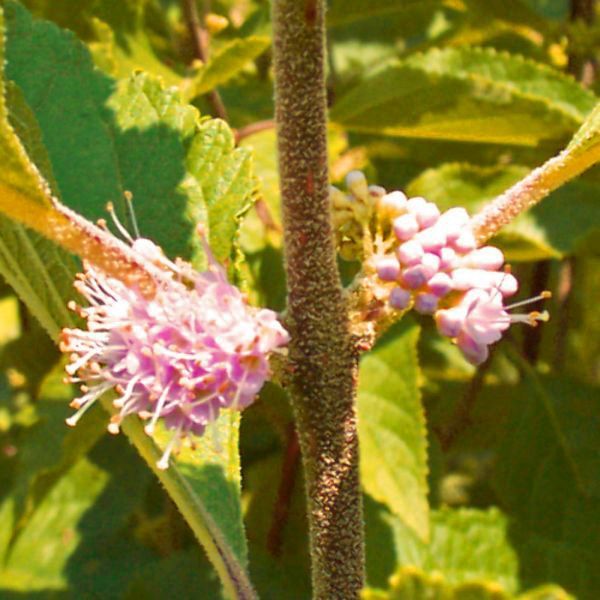FNPS Plant Database
Callicarpa americana
Nomenclature
Common Name:
Synonym(s):
Genus species:
Family:
Lamiaceae (Labiatae)
Plant Specifics
Form:
Size:
Life Span:
Long-lived perennial
Flower Color:
Fruit Color:
Phenology:
Noted For:
Landscaping
Recommended Uses:
Specimen plant, mass planting, casual shrub screen
Considerations:
Availability:
Propagation:
Seed.
Light:
Moisture Tolerance:
Always Flooded---------------------------------Extremely Dry
□□□□□□□□□□□□□□□■■■■■■■■■■■■■■■■■■■■■□□□□□□
Usually moist, occasional inundation -to- Somewhat long very dry periods
Salt Water Flooding Tolerance:
Unknown
Salt Spray/Salty Soil Tolerance:
Some tolerance to salty wind but not direct salt spray
Soil or Other Substrate:
Sand, Loam
Soil pH:
Suitable to Grow In:
8A,8B,9A,9B,10A,10B

USDA zones are based on the average annual extreme minimum winter temperature.
Don't know your zone? Click here to search by zip code.
Ecology
Wildlife:
Larval host for for spring azure butterflies and snowberry clearwing moths.
Attracts various pollinators, especially bees. Documented bees include Agapostemon splendens, Augochlora pura, Dialictus placidensis, Halictus ligatus, Megachile brevis pseudobrevis and the none-native Apis mellifera (honeybee) (Deyrup et al. 2002).
Many bird species consume the fruit. including catbirds, mockinbirds, and robins.
Native Habitats:
Dry mesic hardwoods, xeric hammock, scrubby flatwoods, flatwoods, disturbed dry-moist woods.
Natural Range in Florida:
Visit the USF Libraries Atlas of Florida Plants
Comments:
Ethnobotany:
Sometimes used to make jelly which is noted for its color.
There are three chemicals in the leaves that may be as effective as DEET as an insect repellant (Cantrell et al. 2005; Cantrell & Klun 2011). One, callicarpenal, apparently deters biting by the yellow-fever mosquito and the mosquito that spreads malaria. Callicarpenal and other compounds isolated from the plant also repell fire ants and ticks.
General Comments:
Fruits are magenta. There is a white-fruited/white-flowered variety, uncommonly found naturally in Florida, that is sold occasionally.
Citations:
Gann, G.D., C.J. Abbott, C.G. Stocking, K.N. Hines, and collaborators. (2001+), Natives For Your Neighborhood. ( https://www.regionalconservation.org/beta/nfyn/plantdetail.asp?tx=Callamer ). Accessed 2025. The Institute for Regional Conservation. Delray Beach, Florida.
Hammer, Roger. (2015). Attracting Hummingbirds and Butterflies in Tropical Florida. University Press of Florida, Gainesville.
Haehle, Robert G. and Joan Brookwell. (1999). Native Florida Plants. Gulf Publishing Company. Houston, TX.
Huegel, Craig N. (2010). Native Plant Landscaping for Florida Wildlife. University Press of Florida, Gainesville.
Nelson, Gil. (2003). Florida's Best Landscape Plants: 200 Readily Available Species for Homeowners and Professionals. University Press of Florida, Gainesville.
Osorio, Rufino. (2001). A Gardener's Guide to Florida's Native Plants. University Press of Florida, Gainesville.
University of Tennessee Extension Service. (2010). Desired pH Range and salt tolerance of common nursery plants. ( https://plantsciences.tennessee.edu/wp-content/uploads/sites/25/2021/10/Desired-pH-Range-List.pdf ). Accessed 2025. University of Tennessee Extension, Knoxville.
Watkins, John and Thomas Sheehan. (1975). Florida Landscape Plants, Native and Exotic. University Press of Florida, Gainesville.
Wunderlin, R. P., B. F. Hansen, A. R. Franck, and F. B. Essig. (1999+). Atlas of Florida Plants. ( https://florida.plantatlas.usf.edu/ ). [S. M. Landry and K. N. Campbell (application development), USF Water Institute.] Institute for Systematic Botany, University of South Florida, Tampa.














